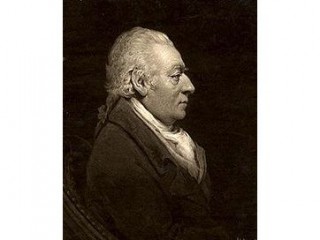
James Wyatt biography
Date of birth : 1746-08-03
Date of death : 1813-09-04
Birthplace : Blackbrook Farm, Weeford
Nationality : English
Category : Arhitecture and Engineering
Last modified : 2012-01-25
Credited as : architect, neo-Gothic style,
0 votes so far
Wyatt spent six years in Italy, 1762–1768, in company with Richard Bagot of Staffordshire, who was Secretary to the Earl of Northampton's embassy to the Venetian Republic. In Venice, Wyatt studied with Antonio Visentini (1688–1782) as an architectural draughtsman and painter. In Rome he made measured drawings of the dome of St. Peter's Basilica, "being under the necessity of lying on his back on a ladder slung horizontally, without cradle or side-rail, over a frightful void of 300 feet".
Back in England, his selection as architect of the proposed Pantheon or "Winter Ranelagh" in Oxford Street, London brought him almost unparalleled instant success. His brother Samuel was one of the principal promoters of the scheme, and it was doubtless due to him that the designs of a young and almost unknown architect were accepted by the Committee. When the Pantheon was opened in 1772, their choice was at once endorsed by the fashionable public: Horace Walpole pronounced it to be "the most beautiful edifice in England".
Externally it was unremarkable (illustration, right), but the classicising domed hall surrounded by galleried aisles and apsidal ends, was something new in assembly rooms, and brought its architect immediate celebrity. The design was exhibited at the Royal Academy, private commissions followed, and at the age of 26 Wyatt found himself a fashionable domestic architect and an Associate of the Royal Academy. His polished manners secured him friends as well as patrons among the great, and when it was rumoured that he was about to leave the country to become architect to Catherine II of Russia, a group of English noblemen is said to have offered him a retaining fee of £1,200 to remain in their service. His major neoclassical country houses include Heaton Hall near Manchester (1772), Heveningham Hall in Suffolk (circa 1788-99), and Castle Coole in Ireland, as well as Packington Hall in Staffordshire, the home of the Levett family for generations, and Dodington Park in Gloucestershire for the Codrington family.
In later years, he carried out alterations at Frogmore for Queen Charlotte, and was made Surveyor-General of the Works. In about 1800, he was commissioned to carry out alterations to Windsor Castle which would probably have been much more considerable had it not been for the King's illness, and in 1802 he designed for the King the "strange castellated palace" at Kew which was remarkable for the extensive employment of cast iron in its construction.
Between 1805 and 1808 Wyatt remodelled West Dean House in West Dean, West Sussex. Wyatt’s work was remarkable because it is built entirely of flint, even to the door and window openings, which would normally be lined with stone.
In 1776, Wyatt succeeded Henry Keene as Surveyor to Westminster Abbey (in which year he was appointed Elizabeth, Countess of Home's architect on Home House, though he was sacked and replaced by Robert Adam a year later). In 1782 or 1783 he became, in addition, Surveyor of the Ordnance. The death of Sir William Chambers brought him the post of Surveyor General and Comptroller of the Works in 1796.
Wyatt was now the principal architect of the day, the recipient of more commissions than he could well fulfil. His widespread practice and the duties of his official posts left him little time to give proper attention to the individual needs of his clients. As early as 1790, when he was invited to submit designs for rebuilding St Chad's Church at Shrewsbury, he broke his engagements with such frequency that the committee "became at length offended, and addressed themselves to Mr. George Stewart". In 1804, Jeffry Wyatt told Farington that his uncle had lost "many great commissions" by such neglect. When approached by a new client, he would at first take the keenest interest in the commission, but when the work was about to begin he would lose interest in it and "employ himself upon trifling professional matters which others could do". His conduct of official business was no better than his treatment of his private clients, and there can be no doubt that it was Wyatt's irresponsible habits which led to the reorganization of the Board of Works after his death, as a result of which the Surveyor's office was placed in the hands of a political chief assisted by three "attached architects".
















